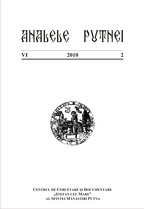Maica Domnului Apărătoare Doamnă şi hramul Mănăstirii Putna
The Mother of God Champion Leader and the Patron Feast of the Putna Monastery
Author(s): Ieromonah Dosoftei DijmărescuSubject(s): History
Published by: Centrul de cercetare şi documentare ŞTEFAN CEL MARE
Keywords: medieval political thought; Moldavia; Mother of God; Putna Monastery; Stephen the Great
Summary/Abstract: The paper tries to prove that by building the Putna Monastery (1466–1469) and dedicating it to the feast of the Dormition of the Mother of God, its founder, Holy Prince Stephen the Great of Moldavia (1457–1504), continued a series of gestures of power of rulers dedicating their countries to the Mother of God and placing their peoples under her protection, thus placing Moldavia under the protection of the Mother of God. Due to the lack of explicit formulas in the sources, the difficulty of the argument lies in showing how the personal act of the ruler involved the entire country. The proof uses on the one hand the comparative method, presenting similar instances, especially from the Byzantine Empire and from the Russian lands, in which an explicit dedication is made, and on the other hand arguments from the Christian Orthodox theology, based on an analysis of Father Dumitru Stăniloae which explains from a dogmatic point of view why the Mother of God naturally patronizes all countries and communities. The examples include references to: the Akathist Hymn, the robe and the girdle of the Mother of God, the wonderworking icons from Blachernae and Hodegon, the Hagia Sofia, the Vladimir icon of the Mother of God, the Dormition of the Mother of God Cathedral from Kremlin, the Protection of Most Holy Mother of God on the Moat – Basil the Blessed Cathedral near Kremlin, the Peć and Studenica monasteries, victories of the Byzantine emperors and of the Russian Tsars attributed to the Mother of God, Saint Stephen of Hungary, Saint Simeon the myrrh-streaming – former prince Stephen Nemania of Serbia. For the Romanian Principalities instances of the protection of the Mother of God can be found with Constantin Brâncoveanu, Vasile Lupu, Ieremia Movilă, Petru Rareş, in the iconography of the Mother of God from the 16th century churches with exterior painting, with the wonderworking icons from Prodromou Skete (Athos) and Neamţ, Hotin and Bisericani monasteries and with other important churches dedicated to the feast of the Dormition of Mother of God.
Journal: Analele Putnei
- Issue Year: 2010
- Issue No: 2
- Page Range: 39-80
- Page Count: 42
- Language: Romanian
- Content File-PDF

